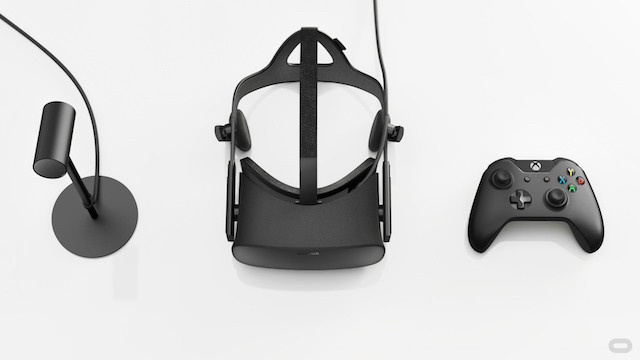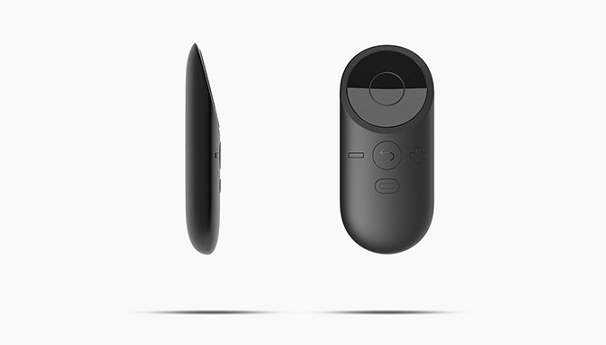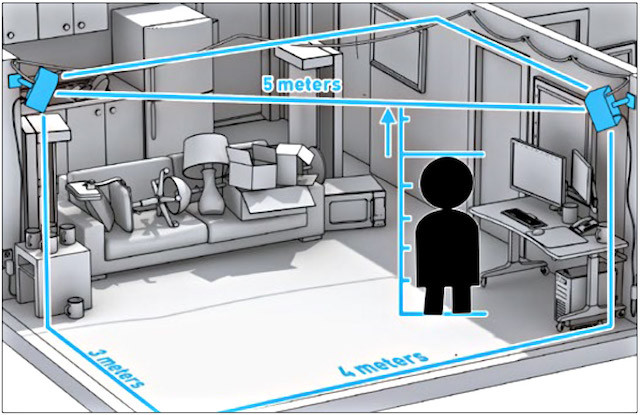

The age of virtual reality is finally within grasp. We are but a few months away from the first commercial release of an affordable, high-quality VR device — but just like a bus, you wait for ages, then three come along all at once.
Let’s take a look at what we know so far about the VR offerings from the major players to see which one is the right one for you to buy.
Internally, the Oculus Rift features two 1080 x 1200 OLED screens for a combined resolution of 2160 x 1200 at 90Hz. In total, this is a little higher than Full HD resolution but not by much, and each eye will receive less than Full HD resolution.
The Rift can adjust to a variety of eye widths due to its inter-pupillary distance adjustment mechanism, and it should accommodate all but the biggest of glasses. However, thanks to the infinity-focused lenses, if you have far-sighted vision, you should be able to see fine even without their glasses. (This is true of all the first-generation VR headsets.)

The headset uses on-board telemetry combined with a single USB camera to provide positional tracking. An array of infrared LEDs on the front of the headset allows the camera to see where it is in 3D space.
Partnering with Microsoft to ensure rock solid Windows 10 support, Oculus has taken the bold move of initially selling the headset without VR-specific controllers, opting instead to give everyone an Xbox One controller. This enables developers to target a single controller that everyone will have, and is the most familiar control method that developers have been working with since the very first Oculus development kit back in 2012.
Also included is an Oculus Remote, a simple pointer device that’s simple to an Apple Remote, which can be used to easily navigate the menu systems of Oculus Home. The stated battery life is 4,000 hours.

Oculus Touch is a pair of handheld controllers that offers positional tracking, recognition of simple gestures like thumbs-up or pointing, and provides a small amount of haptic feedback. Touch is not included in the base purchase price of the Rift and won’t be available until launches separately later in the year.
The Oculus Touch controller package is expected to include an additional tracking camera, which should allow for larger-scale VR experiences, and will only be limited by USB cable length. However, Oculus has noted on numerous occasions that they are primarily targeting “seated experiences” rather than room-scale VR interactions.
Oculus is owned wholly by Facebook, and Oculus founder Luckey Palmer has said that this enables them to sell “at cost” (or as close to it as they can). If we assume that’s true, it’s likely that the $650 price of the Rift will actually be one of the cheapest options, or at least a technically superior option if other headsets cost the same.
Oculus Rift can be pre-ordered now, but while the first units will be shipping at the end of March, new orders have already slipped to July. Pre-ordering the Rift reserves your place in line for the pre-order of the Oculus Touch controllers, the price of which remains unknown but will unlikely be more than $200.
Users outside of the U.S. should also be aware of additional costs for VAT, import fees, and potentially high shipping rates. Australian customers in particular should expect a price closer to $1,000 USD just for the headset.
It’s worth noting that the Rift will require a beefy PC (check if your PC can handle it). NVIDIA has stated that rendering the quality required for a comfortable VR experience requires about seven times as much processing power as regular PC gaming. Currently, the recommended minimum specs are:
If you need to replace your entire PC and have decided to buy a Rift, you may want to look at the Oculus-approved PC bundles being offered by Dell. For $1,500, you’ll get a suitably powerful PC and the headset itself, saving around $200 on the regular retail price, and you may even receive your bundle earlier than those who have pre-ordered just the headset.
Since Rift development kits have been available for several years now, more developers are familiar with the system than any other. Included in the launch package are two full games: Lucky’s Tale, a family friendly platformer, and EVE:Valkyrie, a space-based dog-fighting sim (though not exclusive to the Oculus Rift).
Oculus has promised to have over 100 full gaming titles available by the end of 2016, including Minecraft, and is funding the development of a number of exclusive titles. Rockband VR from Harmonix has also been announced as an exclusive.
The Vive is the result of a collaboration between hardware manufacturer HTC and gaming platform Valve. HTC has even gone to say they may halt production of smartphones and concentrate exclusively on VR, though Valve had initially indicated that HTC would be the first of many partners with whom they collaborate.
Valve was heavily involved in early Oculus development before the Facebook buyout, and this headset is identical to it in terms of screen specs, running at 2160 x 1200 with 90Hz and a similar field of view. However, testers have reported slightly better lenses on the Rift.
The Vive’s positional tracking is accomplished with the help of two laser-emitting base stations that are positioned in the corners of your play space. These emit an encoded signal, which sensors on the headset and controller interpret to provide location information. This allows for room-scale VR experiences out of the box.
The base stations can be at most 16 feet apart diagonally, but the defined play space doesn’t have to be a precise square. For example, 13 feet by 10 feet is fine. The base stations can be mounted to the wall, ceiling, a tripod, or just placed on a shelf. (This is based on development kit information. The final size of the play space may change for the final version.)

At CES 2016, HTC announced a breakthrough addition to their hardware: a front-facing camera. This opens up possibilities for Augmented Reality applications, though none have yet been demonstrated. However, it was shown to work in conjunction with the existing Chaperone system.
The Chaperone system detects when the user approaches the boundaries of the physical play space, and upon detection, the front-facing camera allows a bit of the real world to bleed into the virtual environment so the user can see exactly what it is that they’re about to bump into.
Originally scheduled for a holiday 2015 release, the decision was made to delay until April 2016. The current version being demoed (“Pre”) was slated to be the final iteration before consumer release, but it’s now rumored that additional changes are to be scrapped and the Pre will actually be the final consumer release.
Valve has not stated an exact minimum spec, but we can assume it’s similar to the Rift.
From a content perspective, it’s likely than anything released on Steam VR will also be compatible with Oculus Rift. Valve is first and foremost a gaming platform, after all, so their intention is to sell as many game copies as possible. The reverse isn’t true though. Some Rift content may be exclusive to the Oculus platform.
That being said, there may be differences in the experience. The creators of Job Simulator, for example, have clarified that the game will feature full 360-degree environments on the Vive but will be restricted to 180-degree environments for front-facing camera setups, such as the Rift and PSVR.
The Gallery: Call of the Starseed is a Myst-like adventure game, but looks to be a great example of how games could integrate room-scale VR experiences. They’ve developed a Blink motion system, which enables players to both walk around their Chaperone area, and teleport in an instant to further distances. The system allows for various play space sizes.
Hover Junkers is another fantastic example of how room-scale experiences will work, albeit with a fixed play space. It’s a multiplayer FPS where you’re confined to a hovering ship, roaming the wastelands in search of other junkers to attack, and loot.
The price rumor is based mainly on the comments of Sony, who said that PSVR would cost “around that of a new console”. Even including the cost of a Playstation, the price of entry for PSVR may be significantly lower than that of a PC-based setup.
For this reason, it’s expected that PSVR will have the greatest market penetration and should therefore be a prime candidate for exclusive titles.
#PlayStationVR cable features power, volume, mic controls, first images revealed: https://t.co/bMT3PCykef pic.twitter.com/7wzvQxAlzB
— VRFocus (@VRFocus) December 5, 2015
The PSVR display is 1920 x 1080 with a field of view of 100 degrees. This is a slightly lower quality than both the Rift and Vive, but not as much as to severely detract from the experience. However, it is capable of running up to 120Hz.
The PSVR headset also requires an external processing unit that’s a bit smaller than a Wii. The unit can also output to a connected TV, and with multiple controllers, it’s possible that this will allow for friends to take part in the experience outside of the headset.
The launch date was initially slated for Q2 2016, but this is looking increasingly unlikely. Personally, I expect they’ll aim for the latter half, possibly even the holiday season, but we should have more solid information by the time E3 arrives in June.
The official VR experiences should get you sufficiently excited. For more on the individual games, check out the rest of the official playlist. Fans of the classic giant mech-fighting genre will particularly enjoy the immersion offered in Rigs.
Notably absent from the official promos, despite being an exclusive, is Summer Lesson – a quirky “communication experience”, though that’s probably just an obscure way of saying it’s a dating sim. It’s unclear if this will receive an international release or if it will be Japanese only. My guess is on the latter.
Another exclusive, those seeking tripping musical experiences should look forward to the rebirth of Rez.
Don’t get too bogged down with the internal specs. Once the headset is on and you’re teleported to a distant land, you really won’t notice. The games themselves will dictate the winners of this generation — and there’s such a wide range of games planned that surely one will be the “killer app” for you.
Sony has the largest potential install base, but will console gamers dismiss VR as just another fad? Oculus has the backing of Microsoft for the best Windows support, and if exclusive, Minecraft VR could be the killer title. The HTC Vive might offer the superior Holodeck-like experience that we’ve dreamed of, but at what cost?
For what it’s worth, I can’t decide either. As an original Kickstarter backer, I’ll be getting a free Oculus Rift, but the promise of room-scale experiences is compelling — and I wouldn’t like to miss out on those Playstation VR exclusives either, even if it means trading in my Xbox for a Playstation.
I can tell 2016 is going to be an expensive year.
Which will you buy? Does your hatred of Facebook run so deep as to ignore the Oculus Rift? Will HTC even be around to support their device in a year’s time? Will Sony’s VR go the way of the Kinect? Tell us what you think in the comments!




 10 iPhone and iPad Apps That Take Accessibility To The Next Level
10 iPhone and iPad Apps That Take Accessibility To The Next Level 2012: Fantastic For Strategy Games
2012: Fantastic For Strategy Games 8 Things You Didn't Know You Could Do with a PDF
8 Things You Didn't Know You Could Do with a PDF The Best Gaming Podcast Ever: Episode 7
The Best Gaming Podcast Ever: Episode 7 How to get the 5 best Titan Gauntlets in Destiny
How to get the 5 best Titan Gauntlets in Destiny